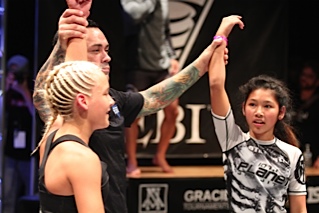 |
| EBI multi-event champ Gary Tonon (left), squaring off against Stephen Martinez at EBI5, is the posterboy for the new, submission-first, sport jiu-jitsu |
And so the legend of the rubber guard was born. The rubber guard was essentially shorthand for a version of jiu-jitsu, particularly without the gi, focused on maintaining connection with the opponent at all times with a multi-limbed combination of overhooks and underhooks. For Bravo, this system of holding, clinching, entangling, and squeezing could save jiu-jitsu competitors entering the world of MMA from suffering the kind of brutal, ground and pound assault then-typified by a fight like Mark Kerr versus Fabio Gurgel.
And it's also worth mentioning that while leg attacks aren't necessarily considered a "core" feature of the rubber guard, Bravo's friendliness toward not just kneebars, toeholds, and heel hooks, but calf cranks such as the one he attacked Royler Gracie with in their rematch, are also positive contributions to no-gi sports jiu-jitsu. But it is clear that at this point Bravo's rubber guard innovations are largely accomplishments for the sport of competitive jiu-jitsu, not for jiu-jitsu in MMA (for this, I continue to point in the direction of Demian Maia's masterful combination of chain wrestling and grapple-first-last-and-always attitude).
 |
| If only Grandmaster Helio would have lived long enough to see this ... |
For those unfamiliar, the overtime rules for EBI are essentially this: players alternate attacking each other from an offensively-advantageous position (rear mount with hooks and grips or a armbar from the top position [the arm is hooked but not extended] Bravo calls "spider web"). Here, players still have the opportunity to win by submission or, failing that, to win by a combination of time-to-submission and time-to-escape-from-rear-mount.
What is crucial is that there is no referee or judges discretion in the issuing of points. There is either submission or time (to escape the threat of submission). And while that is not perfect - there are still ways to game the overtime and settle for a "time" victory - it is hard to imagine a rule-set more thoroughly incentivized toward the submission.
 |
| You know your format works when you can get away with putting on Superfights between competitors who aren't even old enough to drive. |
Those of us living in the Pacific Northwest have two great submission-only events - SubLeague in Oregon and Proving Grounds in Western Washington - throughout the year. And perhaps because they are open events, with round robin divisions, that are especially geared toward beginner and intermediate competitors, draws have been less of an issue. But in invitational settings, where players are often more risk-averse, the EBI overtime rule-set is the best way we have seen so far to coax out the ultimate in competitiveness in a sem pultos sem desculpas world.